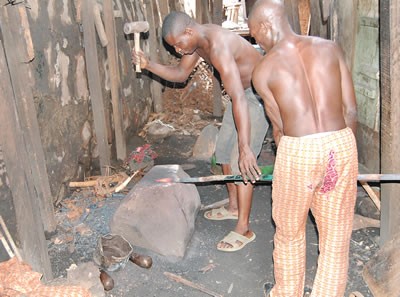
When humans intend to achieve things in life, things must be used either directly or indirectly. The use cannot happen without being specific about which of the available things would deliver the expected values. Before humans were created, things were developed by God because He knew that humans would not survive on earth without having things to use to accomplish things. Human and nonhuman materials work together towards attaining specific goals or results. This leads our analyst to dive into the investigation of a vital material among the Yoruba people, who constitute 21% of Nigeria’s over 200 million population, with a view to developing its short biography.
Cutlass is an English word for the vital material, which means àdá in Yorùbá language. The word Àdá has no etymological nomenclature as to its meaning. However, the morphological analysis of this word can clearly give us a relative semantic meaning for it. It is a joining of the prefix (à-) (meaning something that’s used to) with the verb (dá): divide, part, clear, attack, or waylay (dá as in dá lo nà (to waylay).
The blacksmith makes àdá where he employs the smithery materials such as the metal, the embers, the metal cudgel (omo owú) and the bellows (wìrì). Ògún, the Yorùbá God of Iron, is believed to be the first person to have used àdá in paving the way for the other irúnm (the descending deities) who are believed to have come down from heaven, and on their landing, Ògún, being one of them, paved the way so as to walk freely on earth. Ògún was the first blacksmith to cast metallic tools for war and domestic use.
Register for Tekedia Mini-MBA edition 19 (Feb 9 – May 2, 2026): big discounts for early bird.
Tekedia AI in Business Masterclass opens registrations.
Join Tekedia Capital Syndicate and co-invest in great global startups.
Register for Tekedia AI Lab: From Technical Design to Deployment (next edition begins Jan 24 2026).
As a long slightly curvy metal blade, the Yorùbá farmers use it to clear the bushes or even to cut cassava stems to measurable sizes for planting. During ancient farming practices, àdá contributed to the formation of social structures and the division of labour within Yoruba communities, where individuals specialised in various agricultural tasks. As Yoruba farmers engage in tilling the soil, the cutlass becomes an extension of their bodies, enabling them to clear brush, harvest crops, and maintain the balance between humans and the natural world. It embodies the vibrancy of their connection to the land.
Apart from being a farm tool, it was part of the minor war artillery in the ancient Yorùbá kingdom in fighting battles because it was associated with power and protection. In some Yoruba communities, àdá is used ceremonially during festivals, rituals, and traditional rites of passage. During conflicts, it serves as a self-defense weapon. Warriors and hunters brandish it as a symbol of strength, courage, and defense. It becomes a vibrant embodiment of their martial spirit, reflecting their resilience and commitment to protecting their community.
Anthropologically, àdá reflects the craftsmanship and technological advancements of the Yoruba people in metalworking. Àdá is still evolving and adapting as Yoruba culture does. It finds new uses in construction, handiwork, and even artistic expression, in addition to its conventional agricultural and martial uses. Its vibrant agency endures and resonates with the Yoruba traditions’ enduring vitality in a changing world.
Because Ogun, the god of iron, is thought to be capable of inflicting harm on those who break their oath to speak truthfully or commit to a relationship, àdá is used to ensure commitment to a relationship or force people to tell the truth. Yorùbá culture warns people not to have other relationships besides their partner or spouse, and if they engage in adultery or fornication, they are said to have transformed into a sword because a cutlass lacks two sharp edges.
Viewed through the prism of vibrant matter, Àdá’s biography reveals its active agency and multifaceted function within Yoruba society, which indicates that it can make and mar the attainment of things for the tribe. The cutlass is a symbol of the connection between people and the dynamic world around them, from its creation in the hands of skilled blacksmiths to its embodiment of power, protection, and spirituality. It is evidence of the Yoruba people’s tenacity, inventiveness, and cultural diversity. Indeed, a vital material cannot be thrown away because of its continued benefits, especially when it creates dramatic and subtle impacts.


